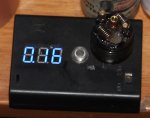Often see people recommending coil calcs such as steam engine.
While back in a facebook group, somebody was mentioning how somebody was using an unsafe build, saying that when he put the guys values into a calc on his cell phone, it was dangerously low. I put the same values into Steam Engine and came up with the same resistance.
then, I put my current coil into Steam Engine, and it was off by quite a bit. And not in a good way. If I followed Steam Engine, my coils would have had much LESS resistance then what it claimed. This could be bad for anybody already pushing the limits of their battery, especially if their Ohms reader is faulty.
My current build:
Dual 22 Gauge Kanthal A1, 7.5 wraps @ 2mm ID, 10-15mm leg length = 0.16 ohms resistance

*however*
According to steam engine, I only need about 6 wraps to get 0.16 ohm resistance off dual coils and 10mm leg length. In fact, even if I lower the leg length to 0, it will only claim 6.8 wraps to get 0.16 ohms.

Anybody have any thoughts on this?
Is steam engine inaccurate or am I just not using it correctly?
While back in a facebook group, somebody was mentioning how somebody was using an unsafe build, saying that when he put the guys values into a calc on his cell phone, it was dangerously low. I put the same values into Steam Engine and came up with the same resistance.
then, I put my current coil into Steam Engine, and it was off by quite a bit. And not in a good way. If I followed Steam Engine, my coils would have had much LESS resistance then what it claimed. This could be bad for anybody already pushing the limits of their battery, especially if their Ohms reader is faulty.
My current build:
Dual 22 Gauge Kanthal A1, 7.5 wraps @ 2mm ID, 10-15mm leg length = 0.16 ohms resistance

*however*
According to steam engine, I only need about 6 wraps to get 0.16 ohm resistance off dual coils and 10mm leg length. In fact, even if I lower the leg length to 0, it will only claim 6.8 wraps to get 0.16 ohms.

Anybody have any thoughts on this?
Is steam engine inaccurate or am I just not using it correctly?




